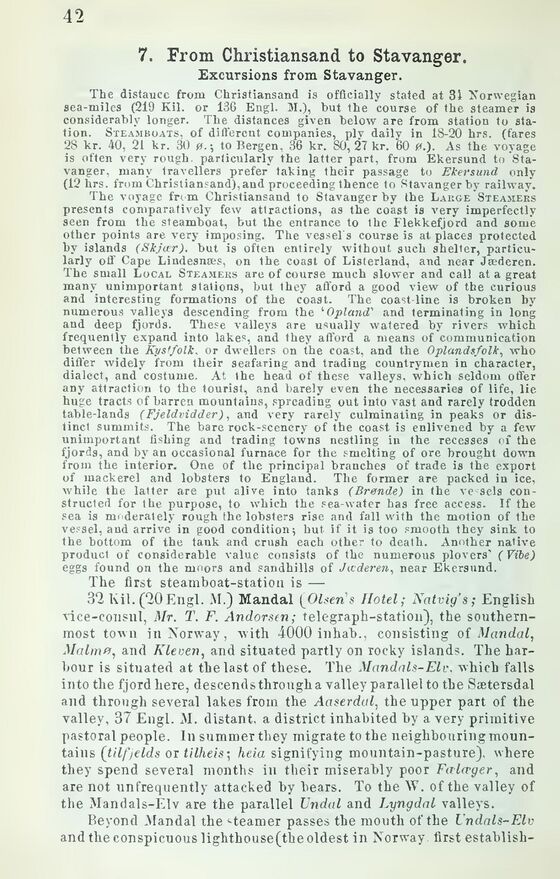
Full resolution (JPEG) - On this page / på denna sida - Norway - Pages ...

<< prev. page << föreg. sida << >> nästa sida >> next page >>
Below is the raw OCR text
from the above scanned image.
Do you see an error? Proofread the page now!
Här nedan syns maskintolkade texten från faksimilbilden ovan.
Ser du något fel? Korrekturläs sidan nu!
This page has never been proofread. / Denna sida har aldrig korrekturlästs.
7. Erom Christiansand to Stavanger.
Excursions from Stavanger.
The distauce. from Christiansand is officially stated at 31 Norwegian
sea-miles (219 Kil. or 136 Engl. M.), but the course of the steamer is
considerably longer. The distances given below are from station to
station. Steamboats, of different companies, ply daily in 1S-20 hrs. (fares
2S kr. 40, 21 kr. 30 0.; to Bergen, 36 kr. SO, 27 kr. 60 ø.). As the voyage
is often very rough, particularly the latter part, from Ekersund to
Stavanger. many travellers prefer taking their passage to Ekersund only
(12 hrs. from Christiansand),and proceeding thence to Stavanger by railway.
The voyage frem Christiansand to Stavanger by the Large Steamers
presents comparatively few attractions, as the coast is very imperfectly
seen from the steamboat, but the entrance to the Flekkefjord and some
other points are very imposing. The vessel’s course is at places protected
by islands (Skjirr). but is often entirely without such shelter,
particularly off Cape Lindesnæs, on Ihe coast of Listerland, and near Jæderen.
The small Local Steamers are of course much slower and call at a great
many unimportant stations, but they afford a good view of the curious
and interesting formations of the coast. The coast line is broken by
numerous valleys descending from the ’■Opland’ and terminating in long
and deep fjords. These valleys are usually watered by rivers which
frequently expand into lakes, and they afford a means of communication
between the Kystfolk, or dwellers on the coast, and the Oplandsfolk, who
differ widely from their seafaring and trading countrymen in character,
dialect, and costume. At the head of these valleys, which seldom offer
any attraction to the tourist, and barely even the necessaries of life, lie
huge tracts of barren mountains, spreading out into vast and rarely trodden
table-lands (Fjeldvidder), and very rarely culminating in peaks or
distinct summits. The bare rock-scenery of the coast is enlivened by a few
unimportant fishing and trading towns nestling in the recesses of the
fjords, and by an occasional furnace for the smelting of ore brought down
from the interior. One of the principal branches of trade is the export
of mackerel and lobsters to England. The former are packed in ice,
while the latter are put alive into tanks (Brønde) in the vessels
constructed for the purpose, to which the sea-water has free access. If the
sea is moderately rough the lobsters rise and fall with the motion of the
vessel, and arrive in good condition; hut if it is too smooth they sink to
the hottnm of the tank and crush each other to death. Another native
product of considerable value consists of the numerous plovers’ (Vibe)
eggs found on the moors and sandhills of Jicderen, near Ekersund.
The first steamboat-station is —
32 Kil. (20Engl. M.) Mandal (jOlsen’s Hotel; Xntviy’s; English
vice-consul, Mr. T. F. Andorsen; telegraph-station), the
southernmost town in Norway, with 4000 inhab., consisting of Mandal,
Malmø, and Kleven, and situated partly on rocky islands. The
harbour is situated at the last of these. The Mandals-Elv. which falls
into the fjord here, descends through a valley parallel to the Sætersdal
and through several lakes from the Aaserdal, the upper pan of the
valley, 37 Engl. M. distant, a district inhabited by a very primitive
pastoral people. In summer they migrate to the neighbouring
mountains (tilfjelds or tilheis; htia signifying mountain-pasture), where
they spend several months in their miserably poor Faiirger, and
are not unfrequently attacked by bears. To the W. of the valley of
the Mandals-Elv are the parallel Undal and Lyngdal valleys.
Beyond Mandal the -teamer passes the mouth of the Undals-Elv
and the conspicuous lighthouse(the oldest in Norway first establish-
<< prev. page << föreg. sida << >> nästa sida >> next page >>